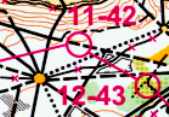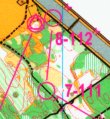World Champs, Hungarian Maps and Lessons
Here's the map for the Sprint Distance in the first World Championship
in France, early July. The "piece de resistance" must surely be the
12-track intersection (pictured). The MTB-orienteer's goal is to
mapread ahead so that you can negotiate such a junction without a pause!
(Pause too long, and you could even lose track of which track you came in on...)

 Click on the left-hand map to see a small section of the map including the
legend (30k) or click on the right-hand map to see the whole map (150k).
Greg and Trevor who were there, the remarks below are guesswork from
a distance, please send us your comments so that we can pass them on to NZ.
Click on the left-hand map to see a small section of the map including the
legend (30k) or click on the right-hand map to see the whole map (150k).
Greg and Trevor who were there, the remarks below are guesswork from
a distance, please send us your comments so that we can pass them on to NZ.
The legend shows the 2 widths and 3 speeds that we have been using, it is
pleasing to see they have adopted the shorter dashes for the slowest tracks
that NZ advocated to the IOF. Of course we can't tell what the actual
classification in the field was like, our mappers will have to go there or vice
versa to get a handle on that. The big question is what do you do with
weather-dependant tracks, such as those that become slippery in the wet,
and sandy tracks that become soft in the dry.
The purple X has been used for some no-go tracks, this could be for land
access, safety, or course-planning reasons. The purple bar has been used for
"obstacles dangerous en route" and we gather that these could have been trees
or closed gates across the track or any other reason to dismount, but too short to
show with a stretch of slow track. To my way of thinking the
purple bar looks a bit too prominent given that it is passable, compared to
the purple cross which isn't.
The control numbering is different from what we have been used to,
which is not surprising since there is no guidance in the mapping specification
and we have been following what was in use in France 5 years ago! So instead
of a big sequence number and small code number in brackets, they have used
sequence number - code number all in the same font. A tiny detail really.
There are other purple markings on the map: vertical stripes, which we are used to
for out-of-bounds, and cross-hatching, which we haven't used so far. This is a
general orienteering symbol meaning "dangerous area", and we don't know whether
this means you were allowed to try it or not. Perhaps the issue didn't arise.
The biggest difference is in the map colouring. While we have coloured all
forest the same light green, the French maps have used both white and
(a small amount of) shades of green as used in foot-orienteering. A closer look
at the specification does actually show that dense and sparse forest
(to the eye not the wheel) may be depicted by green and white, but we're not
sure that the extra work is worthwhile. The important thing for those
competing overseas however is to recognise that white is forest, not
open land as this is not intuitive.
The dotted black shading may have been areas with lots of rocks. If the map
originated as a foot-o map (and there are some hints on the map that this was so)
the rocks would have been mapped in detail. Perhaps
if cliffs etc were visible through the trees they generalised all this into
the black shading.
The maps were all different versions of the same basic area.
The scale for the sprint and classic (longer) distance was 1:20,000 which we have
used on our larger areas such as Hanmer and Poroporo. The short you see here would
have been able to be folded to fit the normal mapholder, but the classic filled the
full A3 and would have required several re-foldings en route.
Strangely, they used 1:15,000 for the relay and this meant the course covered the
full length of the A4, calling for 2 re-foldings.
The contour interval was 5m, providing a lot of information about climbing
if you were able to interpret it. The other way of looking at it, is that kiwis
used to real hills would hardly have noticed it! Most of our mapping has been at
a relatively enormous 20m because the contours are available free ex topo maps,
with only Hanmer and Poroporo at 10m.
To my way of thinking, there wasn't much route choice in the sprint course shown
here, until 9-10 and then on to the finish, when it all gets pretty tight!
Maybe this was their "style"! The classic has longer legs and there are lots of
good route choices there. The relay has quite short legs again and the difficulty
would have been the presence of other competitors. In an orienteering relay
all teams start together, but the courses are broken into sections with say three
variations. Your leg 1 rider might do variation A, your second rider variation B
and your third variation C, while another team might have them in a different order.
That applies to the first segment of the course, if there are several segments
each with 3 variations it is possible to put together lots of different sets
of three courses that are the same in total, but prevent you from following other
riders. Every now and then you have a common control which may let you see some
of the opposition, and of course at the changeover the spectators and waiting riders
can see who is in front. So you have to concentrate on your course while seeing
other riders going all different directions.
We must try one here some day. If anyone feels that an area is getting too easy,
we'll run a relay on it!
 The other map here (click to download 150k) is from the Hungarian MTBO Champs which Michael rode in.
This wasn't as flash as France, in fact rather similar to where NZ is at, with
the exception that Hungary has electronic controls. You carry an electronic stick
(tied to your bike) and stick it into a box at each control. The box writes its
ID and the time onto your stick, at the end you download onto the organiser's
computer, and the results are printed out at intervals. You even get a printout
of all your intermediate times, which can solve those arguments about which
route choice really was better! NZ orienteering has a small set of the gear,
and is set to buy more for the foot-o champs next Easter. No doubt they used
the system in France, too.
The other map here (click to download 150k) is from the Hungarian MTBO Champs which Michael rode in.
This wasn't as flash as France, in fact rather similar to where NZ is at, with
the exception that Hungary has electronic controls. You carry an electronic stick
(tied to your bike) and stick it into a box at each control. The box writes its
ID and the time onto your stick, at the end you download onto the organiser's
computer, and the results are printed out at intervals. You even get a printout
of all your intermediate times, which can solve those arguments about which
route choice really was better! NZ orienteering has a small set of the gear,
and is set to buy more for the foot-o champs next Easter. No doubt they used
the system in France, too.
But back to Hungary, the map shows its origin as a foot-o map with lots
of irrelevant detail between the tracks. The tracks were classified in the
usual way, but in spite of floods elsewhere in Europe the sandy soil was dry
and many of them were worse than indicated. There were about 50 riders, some with
fancy mapholders and lots without, some with fancy bikes and others
with "ride-to-school" mounts. Although helmets are not required on the road
there, most riders wore them, but they didn't prevent a few from riding without.
The start/finish wasn't on a track, and enquiry revealed that Hungarian practice
is that you can ride anywhere. (The international rule is tracks only
unless otherwise specified.) But forest on sandy soil in the middle of
the great plains was not going to offer much of an advantage unless the alternative
was way longer. The grid pattern of the area made the route choices rather simplistic
and Michael found himself re-using tracks, and doing some in-and-outs which are
a bit less satisfying.
Still it's nice to find that there are other countries at about our stage of development,
we can sometimes learn more from our peers than from the advanced countries.
This page was written by Michael Wood,
, and was installed on 1 Sep 02.
Back to the MTBO home page.

 Click on the left-hand map to see a small section of the map including the
legend (30k) or click on the right-hand map to see the whole map (150k).
Greg and Trevor who were there, the remarks below are guesswork from
a distance, please send us your comments so that we can pass them on to NZ.
Click on the left-hand map to see a small section of the map including the
legend (30k) or click on the right-hand map to see the whole map (150k).
Greg and Trevor who were there, the remarks below are guesswork from
a distance, please send us your comments so that we can pass them on to NZ.
